Since its airing, Russell T Davies’ series ‘It’s a Sin’ has become an international success. Inspired by true stories and lived experiences, the show follows the lives of five friends in the 1980s who were living through the AIDS crisis.
Viewers of ‘It’s a Sin’ have been left shocked and heartbroken by the tragedies that unfold. But perhaps most shocking is the apparent lack of awareness about the epidemic which only occurred 40 years ago, and which continues to affect people today.
While advances in medical research have meant that AIDS or advanced-HIV diagnoses are rare, and effective treatments have reduced viral levels in the blood making it undetectable and untransmittable, recent studies suggest that 105,200 people in the UK are currently living with HIV, not to mention the countless number of people who are living with the trauma from this frightening and turbulent time.
This post will discuss the impact of the epidemic on LGBTQ+ lives and the vital work of the community and its allies who were working to combat the medical and social effects of the virus. Materials included throughout, held at The National Archives and provided by Switchboard Archives, demonstrate the importance of education, care and support, and show the ways in which real lives were impacted by HIV/AIDS.
As depicted in ‘It’s a Sin’, news of a ‘cancer’ killing gay men in America began to filter throughout the British Press in the early 1980s. Known at the time as Gay-Related Immune Deficiency (GRID), symptoms included rare forms of pneumonia and unexplained weight loss. Medical professionals were unsure of what was causing the illness, or how it was spread. The first known case was identified in the UK in 1981, and by 1982 the illness had been renamed Acquired Immune Deficiency Syndrome (AIDS) and it had become clear that the infection was not limited to gay men.
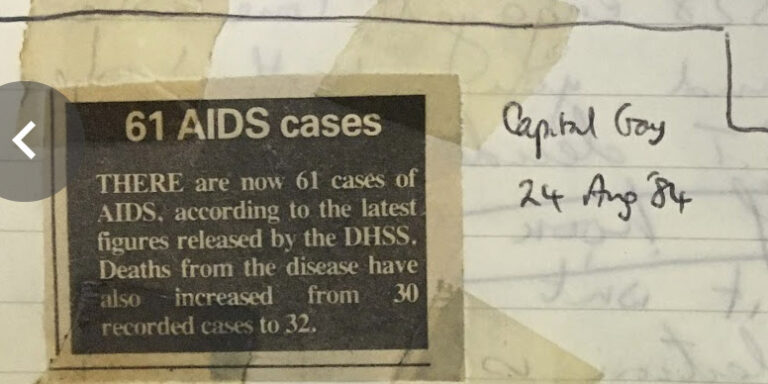
While the government was trying to find out more about this mysterious illness, the LGBTQ+ community and its allies were working together to educate and support one another through this challenging time. As the newspaper cutting above from an 1984 Switchboard logbook demonstrates, people were trying to stay as informed as possible and were sharing whatever credible information they had with one another. But this wasn’t easy. Medical professionals were struggling to understand the causes and effects of HIV and AIDS, and in place of genuine scientific advice misinformation began to spread.
From the start of the epidemic and throughout, helplines such as Gay Switchboard (now Switchboard) and charities such as the Terrence Higgins Trust (founded in 1982) were primary sources of support[ref]Switchboard is an LGBT+ helpline that still runs today, offering support and advice seven days a week. You can find more information or chat with them via their website, or can call them on 0300 330 0630 (every day from 10:00 to 22:00). The Terrence Higgins Trust is the UK’s leading HIV and sexual health charity, and is also able to support those that need them. Find out more about their work and their services here.[/ref]. Natasha Walker, co-chair of Switchboard, notes that ‘Switchboard was the leading source of information on the then new and unknown disease, installing a fifth phone line to deal with the upsurge of calls (June 1984). […] Switchboard’s volunteers collated and maintained a detailed manual of the latest and most up-to-date information available. They not only shared this with the many frightened callers to [the] helpline, but also with the general public, as volunteers staffed the BBC helplines to take calls after programmes about HIV and AIDS’.

In 1983, along with the Gay Medical Association, Switchboard organised and hosted an Open Conference on AIDS (21 May) in which medical experts and activists within the community provided important information on the epidemic, while also highlighting the valuable community support available for those affected or at risk.
Subsequently throughout the 1980s the government was aware of the immense importance of the ‘voluntary sector’ in the fight against AIDS, and sought to ensure that community-led initiatives and charities were provided with the necessary funds to continue their vital work.
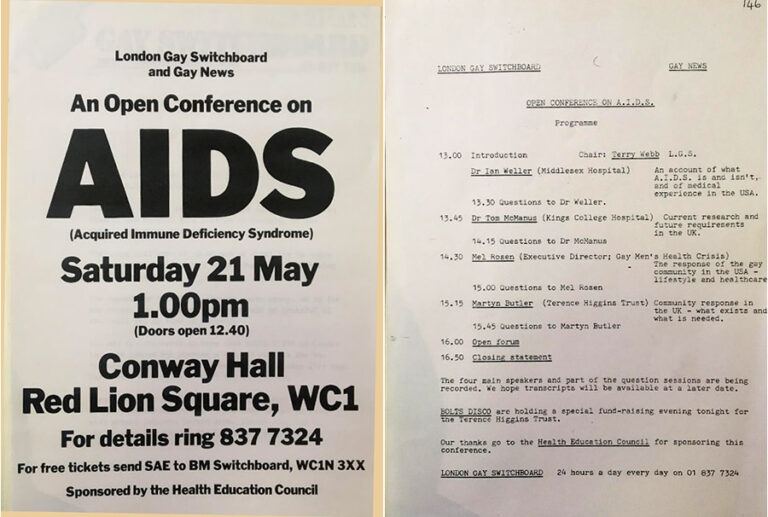
In the course of 1985 the government became galvanised by the growing threat of AIDS. Norman Fowler was Health Secretary and as he wrote later: ‘my view was that we needed a direct advertising campaign explaining how the virus was contracted and warning that there were no drugs or vaccinations that could be used to counter it. The prospect for those who ignored these warnings was death’.
Norman Fowler was the driving force behind a public health campaign on an unprecedented scale, beginning with newspaper adverts in the Spring and Summer of 1986, but he had to deal with concerns from Prime Minister Margaret Thatcher and others about the explicitness of the language used to refer to sexual practices (see: The AIDS health campaign – The National Archives blog).
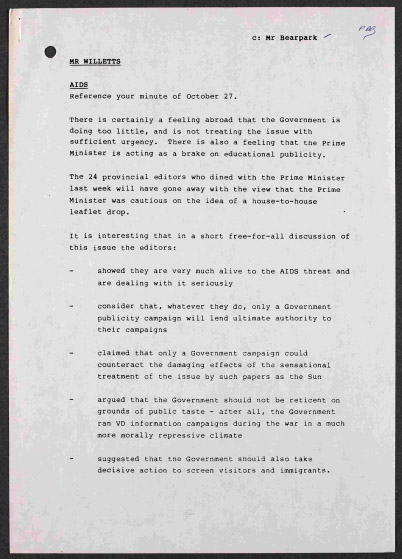
In the Autumn/Winter of 1986, influential figures in government were becoming aware that public concern about AIDS had increased significantly. The government needed to redouble its efforts. In a letter to David Willetts (Policy Unit), former Press Secretary Bernard Ingham wrote: ‘There is certainly a feeling abroad that the government is doing too little, and is not treating the issue with sufficient urgency’. Ministers found it necessary to further their campaigns – prioritising public education on the matter to stop the spread of misinformation and to combat the ‘sensational’ press.
In a letter to Margaret Thatcher, Willetts recommended that the Prime Minister agree to Fowler’s proposal of a leaflet drop to all households in the UK. Following various linguistic edits at the request of Thatcher and other cabinet ministers, the leaflet titled ‘AIDS: Don’t Die of Ignorance’ was produced and delivered to all households. This measure was accompanied by TV advertisements including the impactful tombstone advert voiced by John Hurt that is still remembered today. Documents showing the various stages of the public education campaign, including unpublished proofs for adverts directly targeting gay men, can be found at The National Archives (JA 235/57).
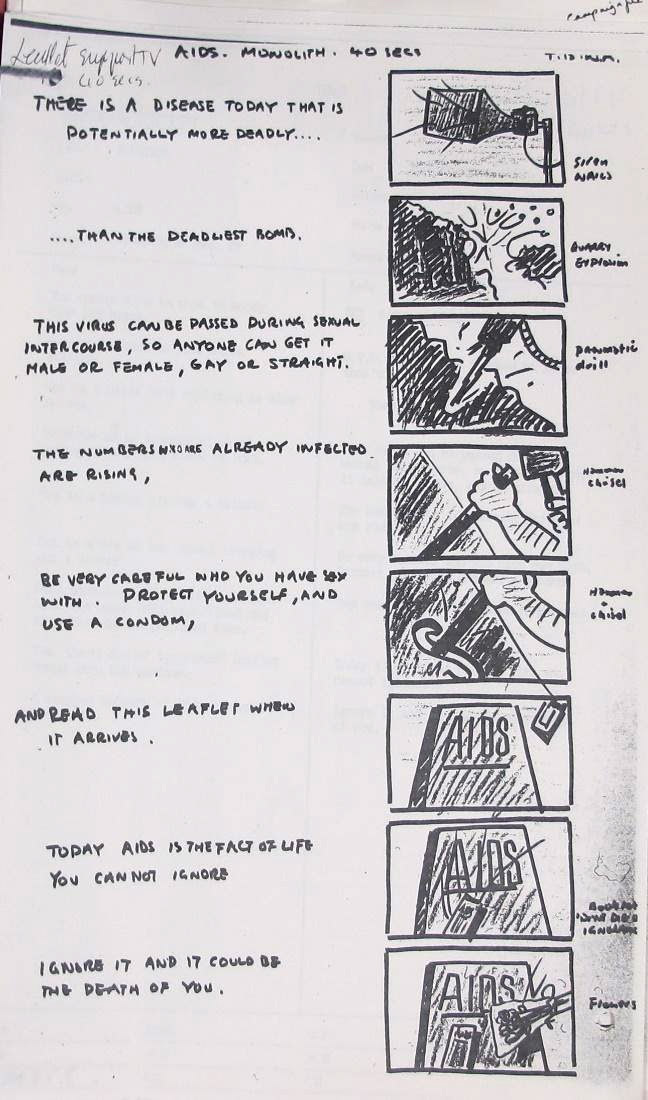
The public education campaign was regarded to be a success. As Lord Fowler, referring to a Gallup report of 1987, explains: ‘well over 90 per cent of the public had seen the advertising, 94 per cent thought that the government was right to be doing the advertising they had seen, and only 7 per cent found some of the things “offensive”’. The National Archives’ Mark Dunton comments: ‘Knowledge about AIDS had increased dramatically and condom use increased. There was also a marked decrease in sexually-transmitted disease among gay men, and in the heterosexual population as well’.
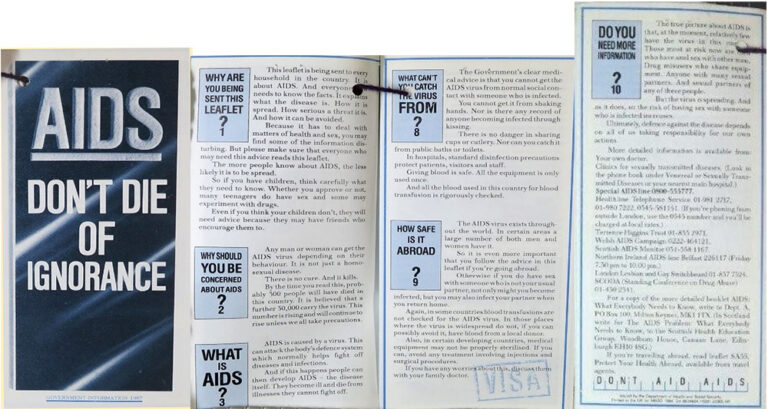
Contact details for community-run support groups and charities were included in the campaign, such as the telephone numbers for the Terrence Higgins Trust and Lesbian and Gay Switchboard, which can be seen on the reverse of the leaflet.
Natasha Walker notes that ‘Switchboard only found out it was to be included the night before they were sent. Needless to say Switchboard was overwhelmed with calls, many from what the volunteers of the time refer to as the “worried well” as well as the many thousands upon thousands of people who were more at risk of contracting HIV’.
The overwhelming calls of concern that followed the distribution of the leaflet were reflective of the real fear and stigma attached to HIV/AIDS, enhanced by a lack of information, misinformation, or ignorant tabloid reporting that resulted in homophobic hysteria.
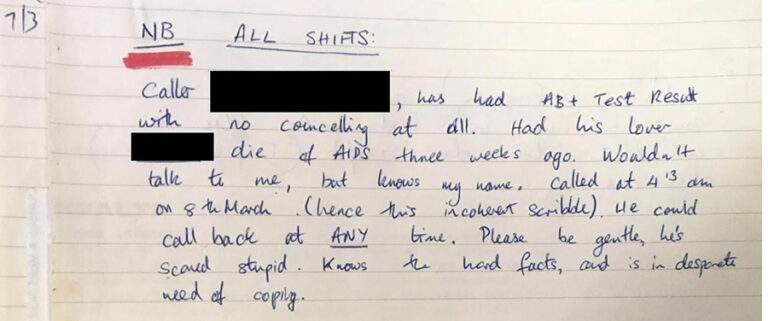
In the midst of the crisis, the LGBTQ+ community was coming together to raise awareness and to combat the impact of the virus in a variety of different ways. Blood drives were organised by lesbian activists following the ban on gay men giving blood, increasing blood supplies at a time in which they were very much needed, and in addition to the Terrence Higgins Trust, groups such as Body Positive were formed.
As well as providing telephone support to those that needed it and visiting AIDS patients in hospital, Body Positive organised and facilitated events for individuals with a positive diagnosis so that they could socialise without fear of ignorance or discrimination. So damaging were the effects of the tabloid press and the prevailing social climate of homophobia that gay men, especially those living with HIV, faced an unprecedented amount of abuse. Charities and community-led initiatives were subsequently instrumental in providing more than just educational information, but also offering necessary emotional support for those affected directly and indirectly by the epidemic.
‘Please be gentle, he’s scared stupid. Knows the hard facts, and is in desperate need of coping’
Switchboard Archives, Bishopsgate Institute LGBTQ+ Archives, ref: SB/5/1/26 c. 1987
In January 1988 (26-28) the World AIDS summit was held in London. Inside, the World Health Organisation and delegates representing 148 countries met to discuss a global initiative dedicated to the prevention of AIDS. Outside, gay rights and AIDS activists were protesting peacefully. The epidemic had impacted LGBTQ+ lives in so many ways, becoming the source of so much prejudice and highlighting many existing injustices. The LGBTQ+ community wanted more than just a cure – they wanted equality, compassion and dignity.
In addition to their commitment to research and funding, on the final day of the summit Ministers of Health declared: ‘We emphasize the need in AIDS prevention programmes to protect human rights and human dignity. […] We shall seek the involvement of all relevant governmental sectors and non-governmental organizations in creating the supportive social environment needed to ensure the effective implementation of AIDS prevention programmes and humane care of affected individuals’.
This summit, the first of its kind, marked a shift in the global response to HIV and AIDS, with medical professionals and officials committing to public education, care, and support, recognizing the impact that the epidemic had both medically and non-medically on the LGBTQ+ community. You can find out more about the summit and its outcomes here (FO 973/559).
Despite the very recent impact of HIV/AIDS, the reaction that has followed the airing of ‘It’s a Sin’ demonstrates a lack of understanding about the epidemic outside of the LGBTQ+ community. As it is an undeniably important part of modern history, we must continue to educate people about the virus – not only about transmission and prevention, but about the struggles of those living with HIV, and those within the community living with the trauma as a result of the epidemic: the stigma, the fear and the shame which had an immense impact on LGBTQ+ lives.
Many thanks to Natasha Walker (co-chair of Switchboard and producer of the podcast ‘The Log Books’) and the Bishopsgate Institute for sharing the materials from the Switchboard Archives, and to Mark Dunton, Principal Records Specialist at The National Archives, for his inspiring talk and for his help producing this blog post.
The National Archives holds a wealth of material relating to the HIV/AIDS epidemic. If you wish to carry out research yourself, start by searching ‘Acquired Immune Deficiency Syndrome’ in our catalogue, Discovery.